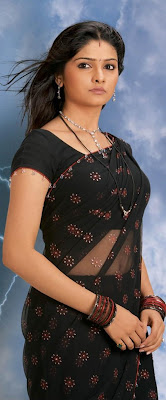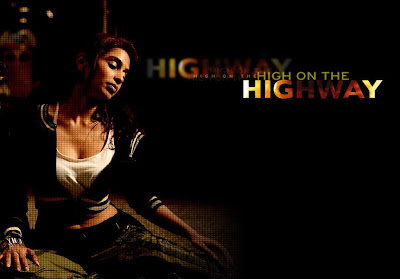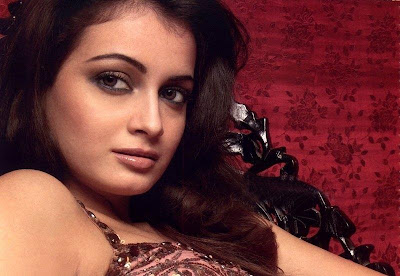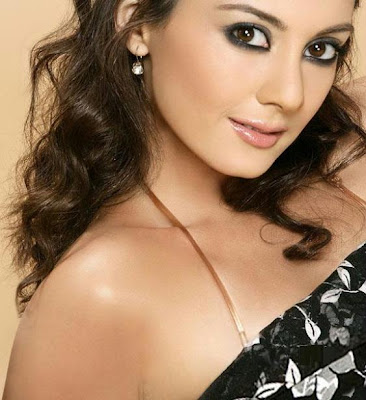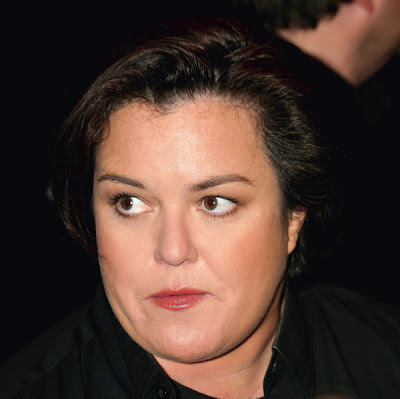|
|---|
Sunday, December 30, 2007
Congratulations to the very creative Spanish ad company DoubleYou (link to a non-site), who have various nice projects,among them the ingenious DoupleYou Loop.
Labels: funny, performing
Friday, December 28, 2007

There is a dark corridor, with just one passage through some light coming from the half-open door to a production room. The corridor is not long, so before I know it, I'm in a black room. There is apparently no light, except for three large, very, very dimly lit images. Actually, they seem more like windows, as what we see on them are interiors - at first glance it is hard to tell whether those are three rooms, or the same one. The rooms have a sensual, soft light, and everything about them seems dream-like.
That is a very comfortable place to be, delightfully melancholy, hidden in the middle, looking out into the private zone, the excessively private zone of what might have been a perfectly regular set of spaces, were they not so hypnotically absent.
If there is something at once appealing and haunting in this triple view, I am reminded that there was a TV set in the entrance. I go back, and the curator Katarzyna Krysiak tells me that although the video is an hour-long loop, it will start again soon and is worth watching at least the first minutes.
So I put myself comfortable. And the same room I saw on one (two?) of the pictures appears. And then, it starts melting. First, the back of the chair thins to nothing, and it falls apart. Then, progressively, the lamp gives way, the bookshelf (how could I have not noticed it before?), the table, the bed... The whole wax model (as it turns out) vanishes bit by bit.
According to the curator, this is the artists reaction to a friend's depression. It is inspired by how a physical space changes in such circumstances.
Johan Dahlberg is a master of disguise. But his masquerades are not about people. Rather, Dahlberg masks space. In his work (check out his site for several other interesting examples), illusion is the basis for questioning our relation with the space we see and feel. It comes as no surprise that among his favorite tools are models of rooms (their doppelgängers) and surveillance equipment. But contrary to many commentators, I have some doubts whether we can define Dahlberg's work through the prism of the "Big Brother" universe. There is so much more in his observing of our observing of an object! Be it with cameras and screens, be it through the nomenclature of surveillance and false spaces. But see, for example, this work from 2000, (Untitled) Billboard,presented in the Swedish town of Uddevalla:
The wonderful quality I find in these works is their capacity to confuse our sense of space, and question the order we assume as self-comprehensive. How mine is this space? Where am I in relation to it? And how sure can I be of it, of what it is?
The exhibition I visited at the Foksal Gallery (on until January 11) is part of an entire cycle called Quiet Home. What is the degree of irony in such a title? That depends on where you find yourself in relation to it, doesn't it?
The pictures from the exhibition courtesy of the Foksal Gallery.
Photos of Untitled (Billboard): copyright Jonas Dahlberg.
Labels: exhibitions, film, painting/photo, Poland
Sunday, December 23, 2007
Friday, December 21, 2007
Thursday, December 20, 2007
Monday, December 17, 2007
Fragment of Amelia, a film by Edouard Lock and La la la Human Steps.
Another chapter of the film is here.
Labels: performing
Three pictures by Anoush Abrar. The first is in co-authroship with Aimée Hoving, and was a co-authorship, a Christmas Cover (!) for Das Magazin. The second comes from a series that answers the theme ""attractive and repulsive images". The second is from the Realdolls series portraying silicone dolls made in California.
Our human selves, as bodies, are shape, are skin, body hair... Manipulating the elements of the definition brings about strange creatures, disgusting and fascinating in their unworldliness. It isn't about the simulacrum, about the virtual dominion over our idea of reality. Rather, it is the exploration of our unrealness, the impossible shape that is human. What are we to do with it? How are we to deal with the body that is never quite what we feel it to be? So the question is not Who am I?, but What am I? How dare I include this and that, and for God's sake where is my perfection?! I deserve it. I deserve corresponding to what I believe in, to what I live as.
But doesn't the language of merit (of deserving) hide our incapacity to cope with the neutrality of what is, or to differentiate between what is and what our concepts allow us to believe?
Labels: painting/photo
Sunday, December 16, 2007
Saturday, December 15, 2007
Roberts is also a pop singer. Her debut album, Unfabulous and More: Emma Roberts, was released in 2005.
Check out her official website here.
Check out Anna in action in this cool video:
Labels: Australian, Golfer, Model
Prachi Desai (with choreographer partner Deepak Singh) became the winner of Sony TV's dance show Jhalak Dikhhla Jaa. Sandhya Mridul (with choreographer partner Javed Sanadi) became the first runner up. Jhalak Dikhhla Jaa is an Indian version of BBC's Strictly Come Dancing and ABC's Dancing with the Stars.
The show is hosted by Mona Singh (winner of season one) and Rohit Roy. The Judges of the show are Urmila Matondkar, Shiamak Davar and Jeetendra.
Other participant of this famous shows were:
Sudha Chandran with choreographer partner Uma Shankar,
Sonali Kulkarni with choreographer partner Toby,
Tapur Chatterjee with choreographer partner Feroz,
Mir Ranjan Negi with choreographer partner Marisha,
Aadesh Srivastav with choreographer partner Tina,
Mini Mathur with choreographer partner Hemu,
Cyrus Broacha with choreographer partner Rozita Rajput,
Ronit Roy with choreographer partner Nicole Alvaris,
Jay Bhanushali with choreographer partner Bindi Khare,
Mika Singh with choreographer partner Tanushree
Friday, December 14, 2007
In a comment in the Portuguese daily newspaper Público, my colleague Tiago Bartolomeu Costa commented on a controversial artistic residency at the Gulbenkian Foundation, which ended in October with a presentation of the works. A number of young visual and performance artists were invited for a 2-month residency in the very space where the Foundation’s collection of contemporary Portuguese art is usually presented. The place was completely transformed into 30 large cubicles or divisions. Visitors to the museum could eavesdrop and discover how each artist develops his work, as the space opened for the general public during several hours in the afternoon. Theoretically, one could accompany the entire process day-by-day (I wonder if anyone tried).
The entire (impressive and extensive) program which incorporated this daring initiative is called The State of the World, and this very title makes me feel somewhat uneasy. But first, let's hear Tiago:
Generally speaking, the protagonists of the arts of the body that were present [during the day of presentation] seem to have wasted an opportunity to reflect about what it means to create today. (...) the propositions (...) had in common what the artist Christian Boltanski called "the small memory" (...), but which to many of the creators became a runaway solution [in Portuguese: escape]: an apology of the idea that a selection of immediate and generational references can substitute, without any loss, History's evolutive processes.There are several very important statements implied in this short fragment.
1) That there is a History. And not many histories, stories, lines. Indeed, in this perspective it is clear that the artists Tiago speaks of missed the point completely. However, "History" remains to be proven. And although History's end has been suspended, this still does not mean we have but the choice of either facing it or questioning it. But the very fact that the word appears here, in all its capital-letter majesty, is not benign. It has to do with the very opinion that artists should work on something called "The State of the World". What World? What State? What are we to do of the the legacy of the last 40 years of thought (and Boltanski is in the midst of it), with its “shift from history to discourse, from a third- to a second-person address” (Craig Owen, quoted from a famous essay called The Allegorical Impulse: Toward a Theory of Postmodernism
2) That there is an evolution, and that it can be ceased. This does make sense if we see any change as evolution. And makes a very interesting point: how do we feel evolution today? Beyond terrorism and cell phones, how does our (my) world pulsate? What leaks? What swallows? What itches? What feels good? I quite agree with Tiago that there is a tension that remains to be read, deciphered, discovered. However,
3) Shouldn't we accept this sort of intimate storytelling as an acceptance of one's own limits, an artistic modesty that is praiseworthy? It might go further than the postmodernist paradigm described through Craig Owens’ words. There is a telling slip of the tongue in the comment. If we read it literally, it suggests that the "selection of references" cannot "substitute History". This, however, implies that the artists put the generational references as an ontological substitute for History's processes. Which they don't (nobody declares or implies that the processes are susbsitututed). The problem might be precisely this: in the case of some of the young performers, the artistic discourse doesn't seem to come near the question of histories vs. History. The modesty seems almost unconscious, more like a limitation than a choice or perspective.
So Tiago does raise an important issue: how can art deal with the world and its new type of globality? We are more conscious today of what the world is than ever before. Might that be why we are more reluctant to generalize, or even try and define its processes? But can we just turn away and ignore them? Of course we can. So why would we participate in an event called State of the World? On one hand, this "small talk" of the "small memory" could be saying a lot about the State of the World, seen from here and now. On the other, its difficulty with approaching these Capital-Lettered-Concepts could be a hint that maybe its time to start off without the caps.
Here is a poem by Wislawa Szymborska, the Polish Nobel-Prize-Winner:
No Title Required
It has come to this: I’m sitting under a tree
beside a river
on a sunny morning.
It’s an insignificant event
and won’t go down in history.
It’s not battles and pacts,
where motives are scrutinized,
or noteworthy tyrannicides.
And yet I’m sitting by this river, that’s a fact.
And since I’m here
I must have come from somewhere,
and before that
I must have turned up in many other places,
exactly like the conquerors of nations
before setting sail.
Even a passing moment has its fertile past,
its Friday before Saturday,
its May before June.
Its horizons are no less real
than those that a marshal’s field glasses might scan.
This tree is a poplar that’s been rooted here for years.
The river is the Raba; it didn’t spring up yesterday.
The path leading through the bushes
wasn’t beaten last week.
The wind had to blow the clouds here
before it could blow them away.
And though nothing much is going on nearby,
the world is no poorer in details for that.
It’s just as grounded, just as definite
as when migrating races held it captive.
Conspiracies aren’t the only things shrouded in silence.
Retinues of reasons don’t trail coronations alone.
Anniversaries of revolutions may roll around,
but so do oval pebbles encircling the bay.
The tapestry of circumstance is intricate and dense.
Ants stitching in the grass.
The grass sewn into the ground.
The pattern of a wave being needled by a twig.
So it happens that I am and look.
Above me a white butterfly is fluttering through the air
on wings that are its alone,
and a shadow skims through my hands
that is none other than itself, no one else’s but its own.
When I see such things, I’m no longer sure
that what’s important
is more important than what’s not.
I know, Tiago - the big question remains: is this, can this small memory be enough? Can we spend time watching little branches and the butterflies' wings, and claim to any sort of authority in regards to the State of the World, or the states of the worlds, for that matter?
It's a beautiful poem. One of the things I like most about it, though, is that Szymborska is not sure. There is a hesitation here. While us, poor contemporary creative bastards, often take it for granted. We just move on, as if this was it.
How many capital letters can we keep? How many should we? Is it a question of the times that are a-changin? The closest I ever came to a war was when the tanks appeared on the streets in Poland in 1981. I was 3. My memory of it is fairly clear. But do I need to have this memory to have my sense of what is important? Can’t we define the world as superficially as we feel allowed to? But shouldn’t a good artist be able to overcome the obstacle of taking all the caps off, and find a capital letter after all, say in the “l” that looks so much like a “1”? But then again, should she? Or is she better off in the small narratives?
Does the “I” only stand for “1”?
= =
NB: Notice that Tiago is a performing arts critic. Would he write something of the sort if he were a fine arts critic? It seems unlikely. The modernist paradigm of an artistic soul that needs not the sullied, exterior world to create, is still quite omnipresent in the fine arts. The performing arts, particularly theater, have quite a different point of view, with a tendency to see the work through the prism of its engagement with the public, its dialog with “society”. I feel more affinity with the latter position. But doesn’t it sometimes limit our appreciation of the generous universe of art?
(photo by Juan Rayos)
Labels: art world, exhibitions, performing, Portugal, theory
Wednesday, December 12, 2007
Labels: commercial, design/architecture
Monday, December 10, 2007
1. Time-based art has one crucial characteristic: it is time-based.
Bare with me.
Whether it's Matthew Barney's latest motion picture or a Dan Graham's classic tableau of the spectator, in this universe, the appearance of something is defined by its appearing.
Well, as obvious as it might seem, this idea is often forgotten and disrespected by both artists and curators... A visit to the Museu do Chiado, where a temporary exhibition of the classics of Centro Pompidou is shown until January, makes it pretty clear. But what makes appearing a problem?
2. First, let’s clear some semantic issues.
What is this thing that is sometimes called “video art”, at other times, “video installation”?
For one, let’s distinguish "sculptural installations that include video" (and call them video installations) from "films shown as a work of visual art, either on a TV screen or a projection or the like" (and call them simply video art).
Also, video art can be closed-circuit (with a live - or near-live - image from a camera) or pre-recorded: this last case is basically a film, whether it’s abstract spots, the film of a tree growing or a narrative fiction (and whether it's single- or multi-channel).
It’s the film I’m interested here in.
3. When entering a room with video art, I have a much better chance of appearing at the middle of the film than at the beginning. But is there a beginning? And does it matter? After all, in most cases of showing a finished, pre-recorded video, and not a closed-circuit video where we are seeing live or nearly-live footage, the artist himself suggested or accepted the idea that his work would be shown in a loop. What does it matter that a time-based work starts anywhere?
A valid argument is that this approach can have substantial causes. The starting point can be irrelevant or of little importance (e.g., in the footage of Gordon Matta-Clark's Day's End), or in Douglas Gordon's Foot and Hand:
It can also be an essential element of the work. After all, the loop might just be the closest we can get to eternity.
Yet this is not always the case.
Not in regards to the works I've seen at the Museu do Chiado. Most of them not only acknowledge the existence of a chronological dynamic, but clearly use it in their very structure.
(The curious thing here is that many of the works at the Museu do Chiado focus on the concept of time. There is talk of empty spaces in time, of the slowing down of time, of the feel of time. And yet, the point (of time) when the spectator enters seems to matter little!) It shouldn’t be surprising that film may well have a dramaturgy that develops over time! We may need to see the work from the beginning to the end to feel it. The only problem is - by the time we've seen it all, we've probably seen the end already and it just doesn't feel the same - sort of like having seen a spoiler in a trailer. You can still enjoy the feature film afterwards, but you wish you didn't know so much.
The other argument is a pragmatic one: how are we to show a film from beginning to end to every single visitor? It seems impossible.
But only at first glance. If you look carefully, you see how technology has changed - and the audience, too. Today, we are out of the videotape era, and we can easily go beyond the loop. We can have a PLAY button on every TV set that shows a work, we can have DVD menus, and even (cheap!) infrared sensors that play the video when a new visitor enters.
And if anyone is worried about the overflow of spectators who make it impossible to keep starting at the beginning - unless you are at the Pompidou or at some other big-shot museum, it really isn't a problem. The museums and galleries still have a tendency to remain empty, there is more than enough time, and if there isn't, hardly anyone will mind waiting a minute longer to see the next work. It will only make her stop a few minutes longer by the previous one. Which wouldn’t be that worrying, now, would it?
4. Another issue comes to mind: What sort of aesthetic experience do we have while loopvision is still the spectators default universe? How do I, as a spectator, deal with seeing something “as if” I didn’t know the end/goal/development? It is not quite as if watching something I’ve seen (in its entirety) before. Could I say I am experiencing something, but acting as if I weren’t experiencing it just yet, fooling myself into a “genuine” experience? But is it not an ever more distant one, a bracketed one?
The brackets... of knowledge? The issue of a well-informed spectator. A too-well-informed spectator. Let’s not over-simplify it into the old discussion of an intelligent reading of a work vs. an emotional living of it. There is more to our experience of a work of art, and it seems a fertile ground for further discussion. There is a sense of an incredibly fertile ground in the multiple and complex layers of what is and could be lived through by the spectator. The on-looker. The in-looker.
PS: Here is a video I would love to see looped and looped and looped- Gilbert and George's Ten Commandments For Gilbert and George.
Notice the modesty in the title. The commandments are for them. They do not feel any need to preach them to the world, beyond proclaiming that this is what they choose for themselves.






























